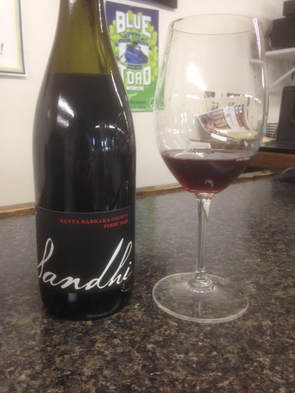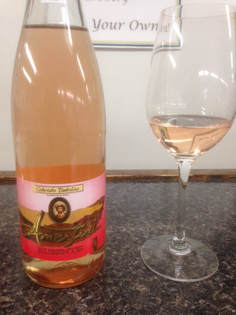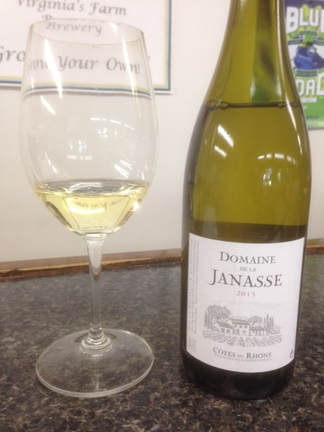 The combination of Sauvignon Blanc and Semillon are the backbone of White Bordeaux, the Sauvignon Blanc providing the crispness and brightness, the Semillon bringing the richness and intensity. In general the more of one varietal in the blend will tip you off to the style of the wine. While many of Australia's over-industrialized wines are combinations of grapes seemingly just because they have so much volume they're blending them willy-nilly in hopes somebody likes them, this is a blend with a long tradition. In fact, Cape Mentelle was among the earliest to bring this type of wine to the cool western edge near Perth, and have a long history of making wines worthy of their Bordeaux origins. They have also shown an ability to evolve in the cellar in much the same way White Bordeaux with fairly large amounts of Semillon can, even since they converted to using screw caps instead of corks. Perhaps not worth keeping for decades, but 8-10 years in the cellar can bring out a unique waxy citrus note. The fresh version pops with the initial cut grass and green citrus of the Sauvignon Blanc, with a slight bit of melon peel emerging after the initial blast settles down. The Semillon really shows up on the palate, rich and almost lemony, a round texture almost Chardonnay worthy but without any oak or signs of butter. There is a nice underlying seashell-like salinity that calls to mind fresh briny oysters coming back into season or a light fresh crab dish. A perfect wine for your last trips to the beach or early Fall picnics.
0 Comments
 Change happens in the wine world at a slow, almost glacial pace. Beer changes season to season, adjustments are made from tank to tank, and every year there always seems to be a new popular recipe created that others begin to emulate by the next year. But wine is a yearly crop that wineries have one chance each season to get right without suffering financial devastation. Vines take upwards of a decade to really hit maturity and produce the quality of grapes that truly show off the long term potential a site contains. Tinkering happens on a relatively small scale, so when Sandhi Wines was formed to create a more elegant and restrained style of Santa Barbara County grown Pinot Noir and Chardonnay, it took place on a parcel by parcel, wine by wine basis. Founders Rajat Parr (wine director of the international Michael Mina Restaurant Group) and winemaker Sashi Morman developed the name to the point that they can now source more fruit from vineyards sites willing to produce grapes to their specifications, enough so that they can now produce a more value conscious bottling instead of just focusing on the more expensive single site wines. Those with a tighter budget can now sample what wineries like this mean when they speak of making 'wines of finesse, minerality, acidity, structure and balance'. A more transparent ruby color combines with a slight haziness from the minimal filtration to give an image in the glass more typical to Red Burgundy than Californian Pinot, as does the aroma of tart cherry and dusty red fruits. The palate still has a Californian richness (often texture gets lost when wines are going for lower alcohol levels to achieve 'balance') but not from leaving sweetness behind, providing lots of the same red fruits in the aroma and lots of dried fruit skin across the finish. This is the opposite of a 'fruit bomb', and does not set out to say that those that like that style are wrong for doing so. What it DOES show is that California is absolutely capable of producing a much broader range of Pinot Noir than many marketers would have you believe for the last few decades, and that you don't have to empty the bank account to explore them any more.  With the weather getting cooler many people start to get out of rose drinking 'season', transitioning to a steadier diet of reds for heartiness instead of refreshment. But we always try to keep a reasonable supply of quality roses around throughout the year, especially ones that have good durability to them. This unique offering from the Basque portion of Spain near Bilbao is one of the more isolated regions culturally and socially, so their wines did not have much exposure to the world. Over the last few decades the region has become a culinary powerhouse, and the awareness of the wines has increased as well, mostly because of their indigenous grapes Hondarrabi Zuri (white) and Hondarrabi Beltza (red), which have virtually no representation anywhere else in the world.. These two grapes provide bright high acidity wines that marry perfectly with the bountiful seafood and locally raised lamb or pork dishes. And this Rose is an equal blend of those two grapes in the style of many classic Provencal wines, so you get the chance to experiment with both at the same time. Bright salmon pink in the glass, the aromas are pure fresh cut strawberries with hints of an underlying citrus fruit and lime peel note, an intermingling of the white and red grapes' aromas on their own. The white wines are known for an almost Vinho Verde level of pinprick sized bubbly texture, but here the wine is still in the glass with all the vibrancy coming from the bright acidity. The palate if full for a rose, with flavors oscillating back and forth between light red tones and green citrus ones. Refreshingly bright and tangy throughout, this has the complexity to be enjoyed well into the colder months. INSIDER'S PICK: 2015 DOMAINE DE LA JANASSE COTES DU RHONE BLANC (Wine Advocate 92points) $19.999/7/2017  As we start to transition from Summer to Fall, wine tastes and selections transition as well. In early Spring we start to see the lighter bodied white wines appear, the ones that taste the best when freshest and take the least amount of time for the wineries to prepare. Now as we go into the cooler months we start to see wines that take a little bit more time to ferment and construct arrive, and are also the ones with a little more oomph and body to them to stand up to heartier cool weather dishes. Not only are there great new wines arriving, but there are excellent deals to be found on any lingering bits and pieces from the previous vintage. Even if it is only a small amount left, it's better for the importers/distributors to get the older vintage out before the new one arrives to conserve space and any confusion. Year in and year out this bottling from one of the Rhone's best producers across all styles and price ranges is a very solid deal. Being able to offer up this at the end of the vintage for under $20 is almost stealing. Primarily Grenache Blanc backed by Clairette and Bourbolenc and a splash of Viognier, the aromas are full of rich citrus and white fruits, as well as a nice pop of wild flowers (a little Viognier goes a long way). There is no oak aging as there is for higher end Chateauneuf-du-Pape Blancs, but a touch of buttery creaminess sits in among the fruit, enough to potentially attract a more adventurous Chardonnay drinker. The palate is a great blend of minerality and viscosity, round and mouth-filling yet still full of tangy fruit and melon rind-like textures. Though it isn't meant to age for decades, an extra year in the bottle has only brought out the underlying complexity, taking some of the immediate youthful fruitiness out and exposing the deeper, drier fruit character. A substantial wine for a not-at-all-substantial price. |
The Best of the Best.We offering free tastings on these wines in the store every Thursday and Friday, and a 10% discount off the retail price through the duration of the day. Come on by and give them a try! Archives
July 2024
Categories |
Location |
|

 RSS Feed
RSS Feed